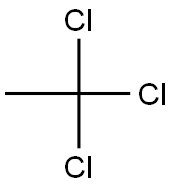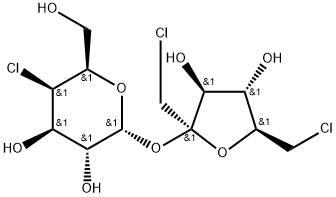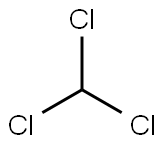PRODUCT Properties
| Melting point: | −35 °C(lit.) |
| Boiling point: | 74-76 °C(lit.) |
| Density | 1.336 g/mL at 20 °C(lit.) |
| vapor density | 4.6 (vs air) |
| vapor pressure | 100 mm Hg ( 20 °C) |
| refractive index | n |
| Flash point: | 11 °C |
| storage temp. | 0-6°C |
| solubility | Sparingly soluble in ethyl alcohol; freely soluble in carbon disulfide, benzene, ethyl ether,
methanol, carbon tetrachloride (U.S. EPA, 1985), and many other organic solvents. |
| form | Fluid |
| Water Solubility | 1.4 g/L (20 ºc) |
| Merck | 13,9710 |
| Henry's Law Constant | 2.77 at 40 °C, 4.27 at 50 °C, 6.31 at 60 °C, 7.91 at 70 °C, 8.98 at 80 °C (headspace-GC, Vane et
al., 2001) |
| Exposure limits | TLV-TWA 350 ppm (~1900 mg/m3)
(ACGIH, MSHA, and OSHA); TLV-STEL
450 ppm (~2450 mg/m3) (ACGIH); IDLH
1000 ppm (NIOSH). |
| Dielectric constant | 7.9(19℃) |
| InChIKey | UOCLXMDMGBRAIB-UHFFFAOYSA-N |
| LogP | 2.490 |
| CAS DataBase Reference | 71-55-6(CAS DataBase Reference) |
| IARC | 3 (Vol. 20, Sup 7, 71) 1999 |
| NIST Chemistry Reference | Ethane, 1,1,1-trichloro-(71-55-6) |
| EPA Substance Registry System | 1,1,1-Trichloroethane (71-55-6) |
Description and Uses
1,1,1-Trichloroethane (1,1,1-TCE) was first identified in 1840 by Henri Victor Regnault, a French chemist and physicist. 1,1,1- TCE is a synthetic chemical that is released to the environment primarily by human industrial activity such as by-process and fugitive emissions during its manufacture, formulation, and use in both consumer and industrial products, which can then undergo thermal and photochemical chlorination. 1,1,1-TCE was originally introduced as a replacement for other chlorinated and flammable solvents like carbon tetrachloride. Although trichloroethane was formerly used extensively in a range of industrial applications and consumer products, including such products as adhesives and adhesive cleaners, lubricants, general purpose liquid cleaners and spray degreasers, oven cleaners, spot removers, shoe polish, and fabric finishes, and as a precursor for hydrofluorocarbons, it is no longer used in common household products. 1,1,1-TCE was one of the compounds addressed by the Montreal Protocol in 1987, which stipulates that the production and consumption of these potentially ozone-depleting substances in the stratosphere were to be phased out. Under this agreement, the final phase out for developed countries for 1,1,1-TCE was 1996, with selected exceptions for existing stocks and essential uses; developing countries have until 2015 for their ban to take effect.
METHYL CHLOROFORM is used in industrial applications as a solvent and a degreasing agent.
Safety
| Symbol(GHS) |  GHS07 |
| Signal word | Warning |
| Hazard statements | H420 |
| Precautionary statements | P502 |
| Hazard Codes | Xn,N,T,F |
| Risk Statements | 20-59-66-40-19-39/23/24/25-23/24/25-11-36/38 |
| Safety Statements | 24/25-59-61-9-46-16-45-36/37-7-26 |
| RIDADR | UN 2831 6.1/PG 3 |
| OEL | Ceiling: 350 ppm (1900 mg/m3) [15-minute] (Chloroethanes) |
| WGK Germany | 3 |
| RTECS | KJ2975000 |
| HazardClass | 6.1(b) |
| PackingGroup | III |
| HS Code | 29031910 |
| Hazardous Substances Data | 71-55-6(Hazardous Substances Data) |
| Toxicity | Acute oral LD50 for dogs 750 mg/kg, guinea pigs 9,470 mg/kg, mice 11,240 mg/kg, rats 10,300 mg/kg, rabbits 5,660 mg/kg (quoted, RTECS, 1985). |
| IDLA | 700 ppm |



